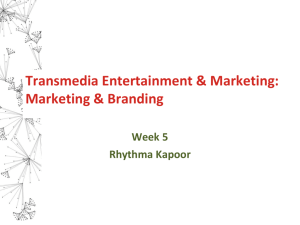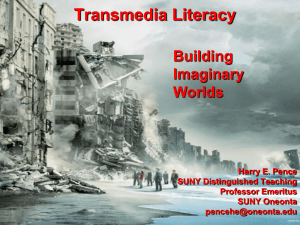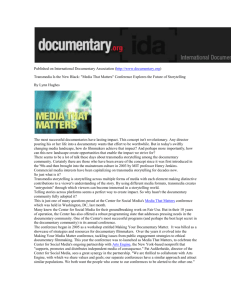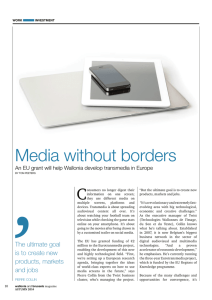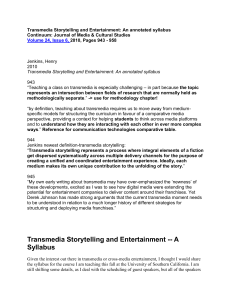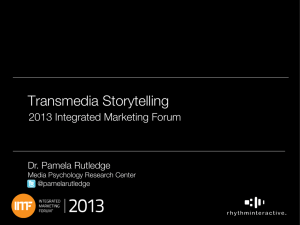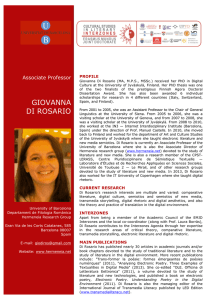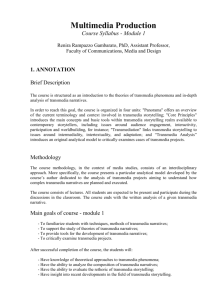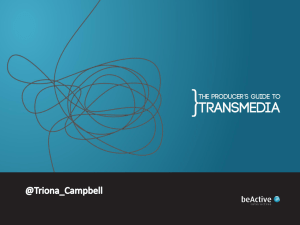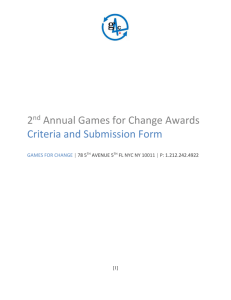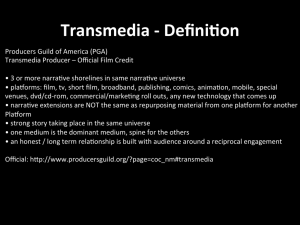Gender in Transmedia Discourse
advertisement
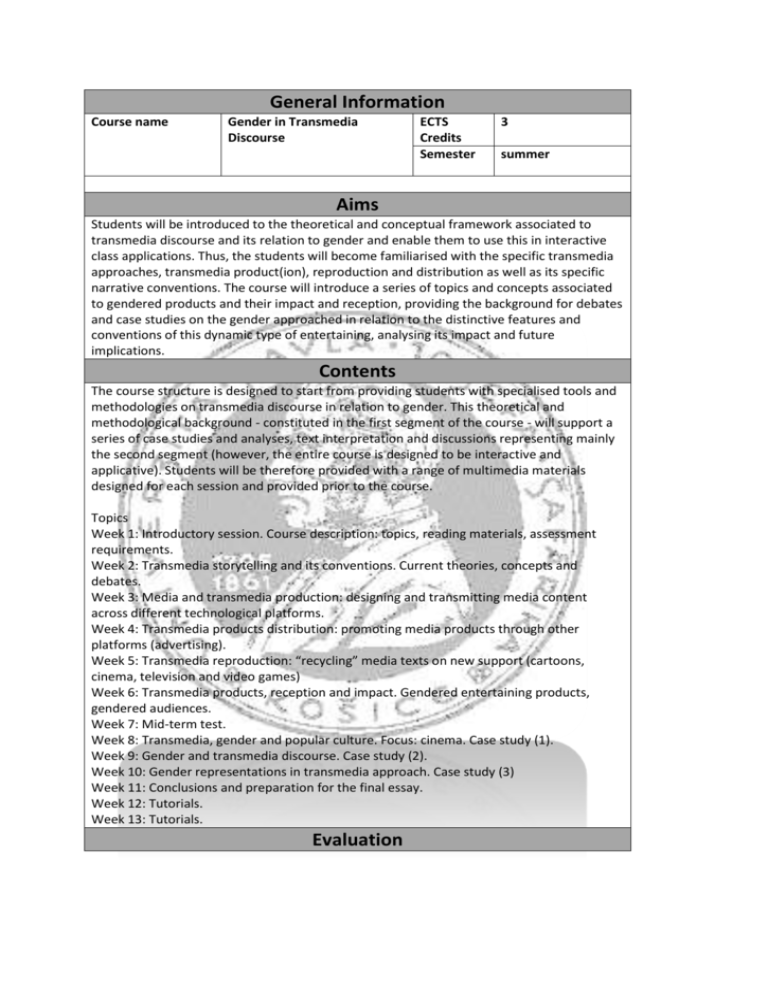
General Information Course name Gender in Transmedia Discourse ECTS Credits Semester 3 summer Aims Students will be introduced to the theoretical and conceptual framework associated to transmedia discourse and its relation to gender and enable them to use this in interactive class applications. Thus, the students will become familiarised with the specific transmedia approaches, transmedia product(ion), reproduction and distribution as well as its specific narrative conventions. The course will introduce a series of topics and concepts associated to gendered products and their impact and reception, providing the background for debates and case studies on the gender approached in relation to the distinctive features and conventions of this dynamic type of entertaining, analysing its impact and future implications. Contents The course structure is designed to start from providing students with specialised tools and methodologies on transmedia discourse in relation to gender. This theoretical and methodological background - constituted in the first segment of the course - will support a series of case studies and analyses, text interpretation and discussions representing mainly the second segment (however, the entire course is designed to be interactive and applicative). Students will be therefore provided with a range of multimedia materials designed for each session and provided prior to the course. Topics Week 1: Introductory session. Course description: topics, reading materials, assessment requirements. Week 2: Transmedia storytelling and its conventions. Current theories, concepts and debates. Week 3: Media and transmedia production: designing and transmitting media content across different technological platforms. Week 4: Transmedia products distribution: promoting media products through other platforms (advertising). Week 5: Transmedia reproduction: “recycling” media texts on new support (cartoons, cinema, television and video games) Week 6: Transmedia products, reception and impact. Gendered entertaining products, gendered audiences. Week 7: Mid-term test. Week 8: Transmedia, gender and popular culture. Focus: cinema. Case study (1). Week 9: Gender and transmedia discourse. Case study (2). Week 10: Gender representations in transmedia approach. Case study (3) Week 11: Conclusions and preparation for the final essay. Week 12: Tutorials. Week 13: Tutorials. Evaluation Mark % A93–100 B86–92 C78–85 D72–77 E65–71 FX64–0 This course follows a continuous assessment model. The final mark will be comprised of three parts: Students will be required to read before each meeting the selection of materials provided to them and use them during the seminars. Classroom performance (attendance, participation, active engagement in debate, etc.) will make up a total of 40% of the grade. Midway through the course, students will be required to take a test on the topics included in the first part of the syllabus (30% of the final grade). An essay to be submitted after the course will make up the other 30% of the grade (specific instructions will be provided in class). Students failing at the end of this assessment process will be expected to rewrite the essay and repeat the test (2 retakes). Bibliography Recommended texts Abba, Tom. “Hybrid stories: Examining the future of transmedia narrative.” Science Fiction Film & Television 2.1 (2009): 59-75. Bolin, Göran. “Digitization, Multiplatform Texts, and Audience Reception.” Popular Communication 8.1 (2010): 72-83. Bolin, Göran. “Media Technologies, transmedia storytelling and commodification.” in Tanja Storsul & Dagny Stuedal (eds): The Ambivalence of Convergence, Göteborg: Nordicom, 2007. Carter, Cynthia, and Linda Steiner (eds.). Critical Readings: Media and Gender. Maidenhead and New York: Open University Press, 2004. Davis, Charles H. “Audience value and transmedia products.”, http://www.ryerson.ca, 2012. Dena, Christy. Transmedia practice: Theorising the practice of expressing a fictional world across distinct media and environments. Thesis Diss. University of Sydney, 2009. Evans, Elizabeth Jane. Audiences for emergent transmedia drama. Diss. Royal Holloway, University of London, 2008. Evans, Elizabeth. Transmedia television: audiences, new media, and daily life. Routledge, 2011. Feng, Yan. “Hypertext and Trans-media.” Comparatioe Literature in China 4 (2002). Humm, Maggie. Feminism and Film. Edinburgh: Edinburgh University Press, 1997. Jenkins, Henry. “Transmedia storytelling.” Volume 1 (2009): 56. Joyrich, Lynne. Re-viewing Reception. Television, Gender, and Postmodern Culture. Bloomington and Indianapolis: Indiana University Press, 1996. Lewis, Jon. The New American Cinema. Durham, NC: Duke University Press, 1998. Lind, Rebecca Ann. Race/Gender/Media: Considering Diversity Across Audience, Content, and Producers. Boston, MA: Allyn & Bacon, 2009. Lotz, Amanda D. Redesigning Women. Television after the Network Era. Urbana and Chicago: University of Illinois Press, 2006. Monaco, Paul. A History of American Movies: A Film-by-film Look at the Art, Craft, and Business of Cinema. New York: The Scarecrow Press, 2010. Morton, Walt. “Tracking the Sign of Tarzan: Trans-Media Representation of a Pop-Culture Icon.” You Tarzan: Masculinity, Movies and Men (1993): 106-25. Norman, Donald A. “The way I see it. The transmedia design challenge: technology that is pleasurable and satisfying.” Interactions 17.1 (2010): 12-15. Qin, Liyan. "Trans-media strategies of appropriation, narrativization, and visualization: adaptations of literature in a century of Chinese cinema.", University of California, San Diego, 2007. Rydin, Ingegerd, and Ulrika Sjöberg. “Transmedia storytelling and young audience: Public service in the blogosphere era.” In T. Olsson (Ed.), Producing the Internet: Platforms, communities, actors. Gothenburg: Nordicom, 2012. Scolari, Carlos Alberto. “Transmedia Storytelling. Narrative Strategies, Fictional Worlds and Branding in Contemporary Media Production.” International Journal of Communication 3 (2009), 586-606. Swartz, Lana. Invisible Children: Transmedia, Storytelling, Mobilization. Working Paper, March 11. http://civicpaths. uscannenberg. Toffoletti, Kim. “Gossip girls in a transmedia world: the sexual and technological anxieties of integral reality.” Papers: explorations into children's literature 18.2 (2009): 71-77. Wolf, Mark JP. “The Subcreation of Transmedia Worlds.” Compar(a)ison: An International Journal of Comparative Literature 2 (2005): 89-101. Compulsory reading materials: A course file will be provided before the beginning of the course, containing the necessary materials for each session (reading load and other multimedia materials). Students will be expected to read/prepare beforehand and use the materials during teaching and tutorial hours.
